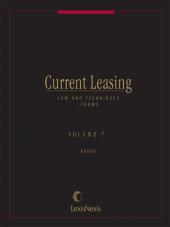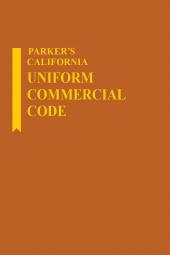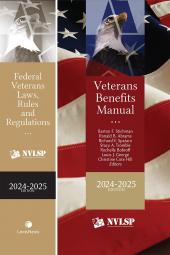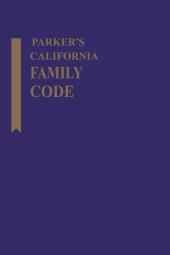Current Leasing Law and Techniques: Forms
Select a format
 International Order Inquiry
International Order Inquiry
Select subscription type
Terms & conditions
Subscribers receive the product(s) listed on the Order Form and any Updates made available during the annual subscription period. Shipping and handling fees are not included in the annual price.
Subscribers are advised of the number of Updates that were made to the particular publication the prior year. The number of Updates may vary due to developments in the law and other publishing issues, but subscribers may use this as a rough estimate of future shipments. Subscribers may call Customer Support at 800-833-9844 for additional information.
Subscribers may cancel this subscription by: calling Customer Support at 800-833-9844; emailing customer.support@lexisnexis.com; or returning the invoice marked "CANCEL".
If subscribers cancel within 30 days after the product is ordered or received and return the product at their expense, then they will receive a full credit of the price for the annual subscription.
If subscribers cancel between 31 and 60 days after the invoice date and return the product at their expense, then they will receive a 5/6th credit of the price for the annual subscription. No credit will be given for cancellations more than 60 days after the invoice date. To receive any credit, subscriber must return all product(s) shipped during the year at their expense within the applicable cancellation period listed above.
The total price includes the product(s) listed in the Order Form and any Updates for a limited period (minimum period of 30 days) after the order is placed ("Order Window"). Shipping and handling fees are not included in the grand total price.
All shipments may be returned, at subscribers' expense, for full credit of the Price within 30 days of receipt.
Shipments may not be returned, and no credits will be issued, more than 30 days after receipt.
After the Order Window, subscribers will receive notice of Updates along with the then-current grand total price and order process as Updates become available. Subscribers will only be shipped those Updates they specifically request.
Product description
Topics discussed in Current Leasing include:
• Legal formalities relating to leases.
• The rights and obligations of the landlord and tenant.
• Tax considerations in real estate leasing.
• Agreements with brokers, managing agents and third parties.
• Basic lease provisions, including provisions for rent and additional rent, defaults, boilerplate, and options to renew, to purchase, and to expand.
• Assignments, subletting, and lease takeover agreements.
• Use and occupancy, repair and maintenance, and insurance.
• Remedies available to the landlord and tenant.
• The effect of bankruptcy on leasing.
• Third-party guaranties of tenant performance.
• Subordination, attornment and non-disturbance agreements.
• Specific leasing transactions, such as shopping center leases, office leases, and store leases.
• Green leases.
Current Leasing is national in scope. It cites cases from across the county that the attorney can use to jumpstart his or her research.
eBooks, CDs, downloadable content, and software purchases are noncancelable, nonrefundable and nonreturnable. Click here for more information about LexisNexis eBooks. The eBook versions of this title may feature links to Lexis+® for further legal research options. A valid subscription to Lexis+® is required to access this content.
Table of contents
CHAPTER 1 INTRODUCTION
1.01 Scope and Organization of the Treatise
1.02 Format of the Treatise
1.03 General Drafting Guide-Checklist of Items to Consider in Drafting,
Assigning or Appraising Leases
CHAPTER 2 LEGAL FORMALITIES APPLICABLE TO LEASES
2.01 The Statute of Frauds
2.02 Recording Act Requirements
2.03 Some Considerations to Be Observed in the Recording of Leases
CHAPTER 3 RIGHTS AND OBLIGATIONS OF LANDLORD AND TENANT
3.01 Habitability of Premises
3.02 Retaliatory Eviction
3.03 Security Deposits
3.04 Unconscionable Leases
3.05 Exculpatory Clauses
3.06 Other State and Local Requirements Regarding Repairs and
Maintenance
3.07 Bibliography and Research Guide
CHAPTER 3A TAX CONSIDERATIONS IN REAL ESTATE LEASING
3A.01 Introduction
3A.02 Basic Tax Concepts
3A.03 General Income Tax Treatment of Lease Arrangements
3A.04 Treatment of Various Project Costs
3A.05 Depreciation Deduction
3A.06 Repair and Maintenance Versus Capital Improvements
3A.07 Rental Activity for Passive Activity Loss Purposes
3A.08 Classification of Income
CHAPTER 3B [RESERVED]
CHAPTER 3C AGREEMENTS WITH BROKERS, MANAGING AGENTS AND THIRD PARTIES
3C.01 Property Management Agreement Establishes Agency Between Owner and Managing Agent
3C.02 Property Management Agreements Define Relationship Between Owner and Managing Agent
3C.03 Checklist for Property Management Agreements
3C.04 Brokerage Agreements Establish Agency Between Real Estate Broker and Landlord or Tenant or Both
3C.05 Brokerage Agreements for Leasing Create Continuing Relationship
Between Owner and Broker
3C.06 Owner or Agent May Enter Into Third-Party Contracts
3C.07 Forms
3C.08 Bibliography and Research Guide
CHAPTER 3D REVIEWING A LEASE-TENANT’S PERSPECTIVE
3D.01 Factors Affecting Lease Negotiations
3D.02 The Tenant Has Legitimate Concerns Regarding the Landlord’s Title
3D.03 The Tenant Should Ensure that the Lease Is Signed by the Proper Person
3D.04 The Premises
3D.05 Defining the Tenant’s Rights and Obligations
3D.06 Length of the Lease Term
3D.07 Options to Renew, Options for Additional Space, Options to Purchase,
and Rights of First Refusal
3D.08 Landlord’s Option to Require the Tenant’s Relocation
3D.09 Rental Obligations
3D.l0 Tenant Inducements
3D.l1 Operating Expenses
3D.12 The Landlord’s Property Tax Obligations May Be Imposed on the
Tenant
3D.13 Late Charges and Interest Are Usually Charged on Late Rent
3D.14 The Tenant Usually Pays for Utilities and Services
3D.l5 The Tenant’s Use of the Premises Is Affected by the Lease and Local
Law
3D.l6 A Tenant’s Right to Alter the Premises Should Be Addressed in the
Lease
3D.l7 Obligations to Comply with Laws
3D.18 Repair and Maintenance
3D.19 Assignment and Subleasing
3D.20 Insurance
iV (Rel. 53-11/2010 Pub.401)
Volume 7 Table of Contents
3D.21 Indemnification and Liability Limitation (Exculpation) Clauses
3D.22 Damage or Destruction of the Premises
3D.23 Condemnation
3D.24 Tenant Bankruptcy Clauses
3D.25 Tenant’s Default
3D.26 Self-Help Provisions May Benefit the Tenant in the Event of the
Landlord’s Default
3D.27 Clauses Addressing the Landlord’s Bankruptcy
3D.28 Lease Termination
3D.29 Security Deposits
3D.30 Sale of the Landlord’s Property
3D.31 Landlord’s Financing
3D.32 Anticipating the Tenant’s Future Financing Needs
3D.33 Tenant’s Rights as to Developing the Property: Landlord’s Easements,
Covenants, and Restrictions
3D.34 Guarantees
3D.35 Leases Frequently Require Tenant Estoppel Certificates
3D.36 The Lease Should Address the Landlord’s Rules and Regulations
3D.37 Recordation of the Lease May Be Opposed by the Landlord Due to Title
Issues
3D.38 Certain Lease Provisions May Be Covered by Boilerplate
3D.39 Landlord-Tenant Disputes May Be Resolved Through Arbitration
3D.40 A Lease Audit Provision Protects the Tenant
CHAPTER 4 BASIC LEASE PROVISIONS
4.01 Basic Lease Provisions
4.02 Term
4.03 Premises: Description and Condition
4.04 Brokerage Considerations
4.05 Sample Commercial Leases
CHAPTER 4A LEASE PROVISIONS FOR RENT AND ADDITIONAL RENT
4A.01 General Considerations in Commercial Lease Rent Provisions
4A.02 Types of Rent
4A.03 Minimum or Base Rent
4A.04 Step-Up Rent Provisions
4A.05 Escalation Clauses
4A.06 Operating Expenses and Other Charges
4A.07 Percentage Rent
4A.08 Lease Audits
4A.09 Statutes of Limitations
4A.10 Checklists for Drafting Rent and Additional Rent Provisions
4A. ll Sample Clauses
4A.12 Bibliography and Research Guide
CHAPTER 4B [RESERVED]
CHAPTER 4C LEASE OPTIONS TO RENEW, PURCHASE AND EXPAND
4C.01 Lease May Grant Lessee Option to Renew
4C.02 Options to Renew Drafting Checklist
4C.03 Lease May Grant Lessee Option to Purchase
4C.04 Options to Purchase Drafting Checklist
4C.05 Lease May Grant Lessee Option to Expand
4C.06 Options to Expand Drafting Checklist
4C.07 Option to Renew Sample Provisions and Forms
4C.08 Bibliography and Research Guide
CHAPTER 4D PROVISIONS CONCERNING DEFAULTS
4D.01 Lease Default Provisions
4D.02 Notice and Cure Period Provisions
4D.03 Materiality of the Lease Default Affects the Remedy
4D.04 Landlord Remedies
4D.05 Defaults Arising from the Landlord’s Failure to Deliver Possession
4D.06 Defaults Arising from a Failure to Repair or Maintain the Premises
4D.07 Defaults Arising from the Landlord’s Interference with Use of Premises
4D.08 Defaults Arising from the Tenant’s Failure to Use the Premises
4D.09 Defaults Arising from the Tenant’s Improper or Illegal Use of the
Premises
4D.10 Default Provisions and the Tenant’s Failure to Pay Rent
4D.l 1 Default Provision and the Landlord’s Duty to Mitigate
4D.l2 Force Majeure Provisions
4D.l3 Alternative Means of Dispute Resolution
CHAPTER 4E BOILERPLATE LEASE PROVISIONS
4E.01 Introduction
4E.02 Appropriateness of Boilerplate Provisions
4E.03 Nonstandard Boilerplate Provisions
4E.04 Standard Provisions
CHAPTER 5 ASSIGNMENT AND SUBLETTING; TRANSFER OF
LESSOR’S INTEREST
5.01 Lease Transfers
5.02 Distinguishing Between an Assignment and a Sublease
5.03 Lease Provisions Addressing Transfers
5.04 Profit Shifting Assignment Clauses
5.05 Application of Lease Transfer Restrictions
5.06 The Transfer of Percentage Leases
5.07 Statutes Regulating Assignments and Subletting
5.08 Transfer of the Lessor’s Interest
5.09 Model Lease Clauses and Forms of Sublease
5.10 Bibliography and Research Guide
CHAPTER 5A LEASE TAKEOVER AGREEMENTS
5A.01 Defined Terms
5A.02 The Lease Takeover Agreement as a Landlord Concession
SA.03 Early Termination or Buyout Under Takeover Lease
5A.04 Default Due to Vacation or Abandonment
5A.05 Assumption Versus Reimbursement
5A.06 Scope of Reimbursement Obligations
5A.07 Due Diligence Review
5A.08 Tenant’s Representations and Warranties
5A.09 Defining the Takeover Period
5A.l0 Method of Payment of Reimbursement Obligations
5A.11 Assignment and Subleasing Issues
SA.l2 Mutual Offset Rights
5A.13 Security for Landlord’s Obligations
5A.14 Form 5A: l-Lease Takeover Agreement
CHAPTER 5B ACQUIRING REAL ESTATE SUBJECT TO LEASES
5B.01 Basic Principles of Real Estate Investment Analysis
5B.02 Valuation Based on Present Worth of Property’s Future Benefits
5B.03 Analysis of Yearly Gross Income
5B.04 Analysis of Yearly Operating Expenses
CHAPTER 6 USE AND OCCUPANCY OF LEASED PREMISES
6.01 The Lessee’s Obligation to Use the Premises
6.02 Vacant or Deserted Premises
6.03 Lessor Imposed Restrictions on the Lessee’s Use and Occupancy of
the Premises
6.04 Residential Premises Used for Business Purposes
6.05 Use of Commercial Property for Residential Purposes
6.06 Illegality of Use
6.07 Use Restrictions Arising from Zoning Laws
6.08 Frustration of Purpose
6.09 The Effect of the Certificate of Occupancy on the Tenant’s Use of
the Premises
6.10 The Tenant’s Manner of Conducting Business
6.11 Implied Warranty of Suitability
6.12 Effect of Lessee’s Use on Insurance
6.13 Alterations
6.14 Covenants Against Competing Uses
6.15 Compliance with Law Provisions
6.16 Agricultural Leases
6.17 A Tenant’s Use of Light and Air
6.18 A Tenant’s Right to Use the Roof of the Leased Premises
6.19 A Tenant’s Right to Erect Signs on the Premises
6.20 Illustrative Clauses
6.21 Bibliography and Research Guide
CHAPTER 6A ENVIRONMENTAL LIABILITY
6A.01 Hazardous Substances and Emissions
6A.02 Federal Statutes Imposing Environmental Liability
6A.03 State Environmental Protection Statutes
6A.04 Environmental Protection Under the Common Law
6A.05 Liability
6A.06 Environmental Site Assessments
6A.07 Title and Property Insurance Considerations
6A.08 Valuation of Contaminated Properties
6A.09 Negotiating Environmental Provisions in a Lease
6A.10 Reference List of Federal Environmental Statutes
6A.11 Forms
CHAPTER 7 LANDLORD AND TENANT REMEDIES
7.01 An Overview of Landlord and Tenant Remedies
7.02 Statutory Provisions Governing Landlord-Tenant Remedies
7.03 Bibliography and Research Guide
CHAPTER 7A THE EFFECT OF BANKRUPTCY ON LEASING
7A.01 The Federal Bankruptcy Code Supersedes State Law
7A.02 The Bankruptcy Code’s Automatic Stay Is a Powerful Tool for the
Debtor
7A.03 Ipso Facto Clauses Are Unenforceable Under the Bankruptcy Code
7A.04 The Bankruptcy Code Allows Assumption or Rejection of
Unexpired Leases
7A.05 Treatment of Rent Due to the Landlord by a Debtor-Tenant
7A.06 Real Estate Taxes and Other Obligations Due Under a Lease
7A.07 The Trustee’s Assignment of a Lease
7A.08 Enforcement of Cross-Default Provisions
7A.09 Going Out of Business Sales Conducted at the Premises
7A.l0 Bankruptcy of the Landlord
7A.11 Forms: Illustrative “Bankruptcy“ Provisions for Commercial
Leases
7A.12 Forms: Illustrative Bankruptcy Litigation Forms Pertaining to
Assumption, Assignment or Rejection of Unexpired Nonresidential
Leases
7A.13 Bibliography and Research Guide
CHAPTER 7B THIRD-PARTY GUARANTIES OF TENANT
PERFORMANCE
7B.01 The General Nature of the Lease Guaranty
7B.02 Guaranty Distinguished from Suretyship
7B.03 Absolute Guaranties
7B.04 Conditional Guaranties
7B.05 Limited Guaranties
7B.06 Special Versus General Guaranties
7B.07 Continuing Guaranties
7B.08 Benefits of a Lease Guaranty Contract
7B.09 Judicial and Statutory Attitudes Toward Guaranties
7B.10 Notice of Acceptance of the Guaranty
7B.11 Consideration
7B.12 Identification of the Lease Being Guaranteed
7B.13 Duration of the Guaranty
7B.14 Holdover Tenants
7B.15 Renewals or Extensions of the Lease Term
7B.16 Assignments of the Lease
7B.17 Notices, Demand, and Waiver of Notice Regarding the Tenant’s
Default
7B.18 Modifications of the Original Lease
7B.19 Changes in the Lease Term
7B.20 The Effect of the Landlord’s Forbearance on a Guarantor’s
Liability
7B.21 Modification of the Rent Amount
7B.22 Reletting of the Premises to Mitigate the Landlord’s Damages
7B.23 Change in the Use of the Premises
7B.24 Unsigned Guaranties
7B.25 Effect of an Illegal or Unenforceable Lease
7B.26 Enforcement of a Guaranty
7B.27 Defenses Against Enforcement of a Guaranty
7B.28 Actions Against the Guarantor
7B.29 Corporate Authority, Corporate Officials and Guaranties
7B.30 Limitation of the Guarantor’s Liability by the Landlord’s
Termination of the Lease
7B.31 Surrender of the Leased Premises
7B.32 The Landlord’s Reentry of the Premises
7B.33 Joint and Several Guarantors
7B.34 Controlling Law
7B.35 Equitable Subrogation
7B.36 Co-Lessees Versus Guarantors
7B.37 Commercial Frustration
7B.38 Death of the Guarantor
7B.39 Judgments
7B.40 Attorney’s Fees
7B.41 Guaranty Insurance
7B.42 Letters of Credit as a Guaranty Tool
7B.43 Bankruptcy
7B.44 Commentary to the Forms
7B.45 Forms
CHAPTER 7C SUBORDINATION, ATTORNMENT & NONDISTURBANCE
AGREEMENTS
7C.01 Basic Concepts of Subordination, Attornment and Non-Disturbance
7C.02 Effect of Foreclosure on Leases Absent Subordination, Attornment,
or Non-Disturbance Provisions
7C.03 Use and Effect of Subordination, Attornment and Non-Disturbance
Agreements
7C.04 Subordination, Attornment and Non-Disturbance Provisions in
Leases Themselves
7C.05 Drafting and Negotiating Subordination, Attornment and Non-
Disturbance Agreements
7C.06 Drafting Checklist
7C.07 Sample Provisions and Forms
7C.08 Bibliography and Research Guide
CHAPTER 8 REPAIR AND MAINTENANCE OF PREMISES
8.01 Repairs Versus Maintenance
8.02 Landlord’s Obligation to Repair
8.03 Condition of the Premises and Liability for Injuries
8.04 Covenants Concerning New Structures
8.05 Conformity with Municipal Regulations, Insurance Laws and Tax
Laws
8.06 Sample Lease Provisions Concerning Maintenance and Repair
Obligations, Insurance Requirements and Damage and Destruction
8.07 Bibliography and Research Guide
CHAPTER 9 INSURANCE ASPECTS OF LEASES
9.01 Losses Arising Out of Liability Claims by Third Parties and
Liability Insurance Coverage
9.02 Losses to the Property of the Landlord and Tenant and Property
Insurance Coverage
9.03 Checklist for Indemnity, Waiver and Insurance Clauses
9.04 Illustrative Clauses in Leases for Indemnities, Waivers and
Insurance
9.05 Bibliography and Research Guide
CHAPTER 10 CONDEMNATION
10.01 Summary of the Law of Eminent Domain as Applied to Leasehold
Interests
10.02 Principles Governing Compensation Awards for a Tenant’s
Fixtures and Improvements
10.03 Buildings Erected by Lessees
10.04 Loss of Business, Profits and Good Will
10.05 Removal and Relocation Expenses
10.06 Drafting Considerations Pertaining to Condemnation Clauses in
Leases
10.07 Illustrative Condemnation Clauses for Inclusion in Various Types
of Leases
10.08 Checklist for Condemnation Clauses
10.09 Briefs and Record on Appeal in a Condemnation Case
10.10 The Role of the Appraisal in the Condemnation Process
10.11 Illustrative Condemnation Litigation Documents Regarding
Valuation
10.12 Bibliography and Research Guide
CHAPTER 11 SHOPPING CENTER LEASES
11.01 Developing a Shopping Center
1l.02 Condemnation-Eminent Domain
11.03 Radius Clauses
11.04 Exclusivity Rights
11.05 Implied Duty to Refrain from Destructive Competition
11.06 Use Clauses
11.07 Restrictive Lease Covenants and Recordation of Leases
11l.08 Parking
11.09 Brokers
11.10 Shopping Centers and First Amendment Issues
11.11 Federal and State Antitrust Issues
11.12 Merchants Associations
11.13 Utilities and Common Area Expenses
11.14 Demalling
11.15 Bankruptcy
11.16 Destruction of the Shopping Center
11.17 Shopping Center Leases: Drafting Guide-Checklist
11.18 Industry Groups
11.19 Forms
11.20 Bibliography and Research Guide
CHAPTER 12 THE SALE AND LEASEBACK OF REAL ESTATE
12.01 Types of Sale-Leaseback Transactions
12.02 Evaluation of a Sale-Leaseback as a Financing Vehicle
12.03 Tax Treatment of a Sale-Leaseback Transaction
12.04 Bankruptcy Treatment of a Sale-Leaseback Transaction
12.05 Forms for Use in a Sale-Leaseback Transaction
CHAPTER 13 GROUND LEASES
13.01 The Nature of Ground Leases
13.02 Ground Leases Utilized in Commercial and Residential
Transactions
13.03 Preliminary Matters to Consider Prior to Drafting Ground Lease
13.04 Negotiating and Drafting Ground Leases
13.05 Ground Lease Forms
13.05 Ground Lease Forms (Cont’d)
CHAPTER 13A LEASEHOLD FINANCING
13A.01 Introduction
13A.02 Regulatory Constraints on Leasehold Mortgage Financing
13A.03 Basic Principles of Leasehold Financing Credit Analysis and Appraisal
13A.04 Legal Aspects of Analyzing Leasehold Collateral
13A.05 Model Forms and Clauses for Leasehold Mortgage Financing Documents
CHAPTER 14 OFFICE LEASES
14.01 Drafting Office Leases
14.02 Drafting Checklist for Office Leases
14.03 Form 14:1-Office Lease with Alternative Provisions
14.04 Sample Rules and Regulations
14.05 Sample Landlord Workletter
14.06 Sample Landlord Cleaning Specifications
14.07 Additional Sample Lease Provisions
14.08 Bibliography and Research Guide
CHAPTER 14A STORE LEASES
14A.01 Drafting Store Leases Generally
14A.02 Store Leases: Drafting Guide Checklist
14A.03 Store Lease Forms
14A.04 Bibliography and Research Guide
CHAPTER 15 AIRSPACE
15.01 Airspace-Introduction
15.02 Transfer of Airspace Development Rights
15.03 Valuation of Airspace
15.04 Drafting Airspace Leases
15.05 Form 15:1-Lease of Space Over Railroad Terminal
15.06 Bibliography and Research Guide
CHAPTER 16 INDUSTRIAL LEASES
16.01 Areas of Special Concern in the Drafting of Industrial Leases
16.02 Form 16:1-Lease of an Industrial Building
16.03 Form 16:2-Standard Industrial/Commercial Single-Tenant Net
Lease
16.04 Ancillary Forms
CHAPTER 17 PROPRIETARY LEASES
17.01 Legal Analysis of Cooperative Apartment Projects and Proprietary
Leases
17.02 Representing the Purchaser of a Proprietary Lease
17.03 Limitations on Actions of the Cooperative Board of Directors
17.04 Checklists for the Sublessor and Sublessee of a Cooperative
Apartment
17.05 Contract and Closing Considerations
17.06 Forms: Standard Proprietary Lease Provisions
17.07 Forms: Acquisition and Transfer of a Cooperative Apartment
17.08 Bibliography and Research Guide
CHAPTER 17A COOPERATIVES AND CONDOMINIUMS BASED ON A
LEASEHOLD
17A.01 Factors Favoring a Leasehold Over Fee Approach
17A.02 State Cooperative and Condominium Law and Statutes Affecting
Leaseholds
iii (ReL 45-11/2006 Pub.0040f)
Volume 7D Table of Contents
17A.03 Uniform Acts and Model Statutes Relating to Leasehold Projects
17A.04 Leasehold Condominiums and Leasehold Cooperatives Compared
17A.05 The Ground Lease and Ground Rent
17A.06 Financing a Leasehold Project
17A.07 Checklist for Leasehold Cooperatives and Leasehold
Condominiums
17A.08 Forms: Sample Offering Plan for a Marina-a Leasehold
Cooperative
CHAPTER 18 THE LEASING OF RESIDENTIAL, COMMERCIAL AND
INDUSTRIAL CONDOMINIUMS
18.01 Introduction
18.02 Uniform Acts Have Been Adopted to Control Condominiums
18.03 Other State and Federal Laws Are Applicable to Condominia
18.04 The Terminology Used in UCA and UCIOA Jurisdictions Is
Defined by Statute
18.05 State Statutes Control Condominium Use
18.06 Condominiums Are Controlled by Their Governing Documents and
an Owners’ Association
18.07 The Elements of Condominium Rent Include the Amount of the
Underlying Mortgage, Common Expense Assessment, and Real
Estate Tax Assessment
18.08 State Statutes Applicable to the Resolution of Disputes
18.09 State Statutes Applicable to Condominium Insurance
18.10 State Statutes Applicable to the Condominium’s Physical Plant
18.11 Commercial Condominiums Established as a Leasehold
18.12 State Eminent Domain and Termination Statutes Can Cause the
Condominium to Cease to Exist
18.13 Forms
CHAPTER 19 RESIDENTIAL LEASES
19.01 The Effect of September 11, 200l on Residential Leases
19.02 Unequal Bargaining Power of the Parties
19.03 Written vs. Oral Leases
19.04 Compliance with Statutory Enactments
19.05 Drafting Specific Residential Lease Clauses
19.06 Mobile Home and Mobile Home Park Space Leases
19.07 Compliance with Federal Law
19.08 Checklist for Residential Leases
19.09 Statutory References for Landlords’ and Tenants’ Remedies
19.10 Manufactured (Mobile) Home Park Space Forms
CHAPTER 20 GOVERNMENTAL LEASES
20.01 Federal Government Leases of Real Property
20.02 Small Business Administration Lease Guarantee Program
20.03 Real Property Leases with State and Local Governments-Checklist and
Sample Limiting Provisions
20.04 Form 20:1-Federal Government Lease Solicitation Forms and Lease for
Property Measuring Less than 10,000 Square Feet
20.05 Form 20:2-Lease of Truck Terminal by New York State Port Authority
With an Amendment Including an Option to Purchase Property
20.06 Form 20:3-Lease of Office Space in International Financial Center-
Government Lessor-Construction of Facility Not Yet Complete
20.07 Form 20:4-Municipal Ground Lease of Landmark Property to Developer
CHAPTER 21 GREEN LEASES
21.01 Green Lease Explained
21.02 Factors Driving the Development of Green Buildings
21.03 Levels of Green Leasing
21.04 Objectives of Green Leases; Addressing the “Split Incentive“
21.05 Third-party Certification Standards for Green Buildings
21.06 Green Leasing Guides
21.07 Common Provisions in Green Leases
21.08 Potential Legal Pitfalls in Green Leasing
21.09 Remedies for Breach of Green Provision
21.10 Green Lease Regulations and Third-Party Certification Programs
21.11 Case Studies of Green Leasing
21.12 Tips for Green Leasing
21.13 Drafting Checklist for a Green Lease
Index
 Lexis Nexis
Lexis Nexis 


